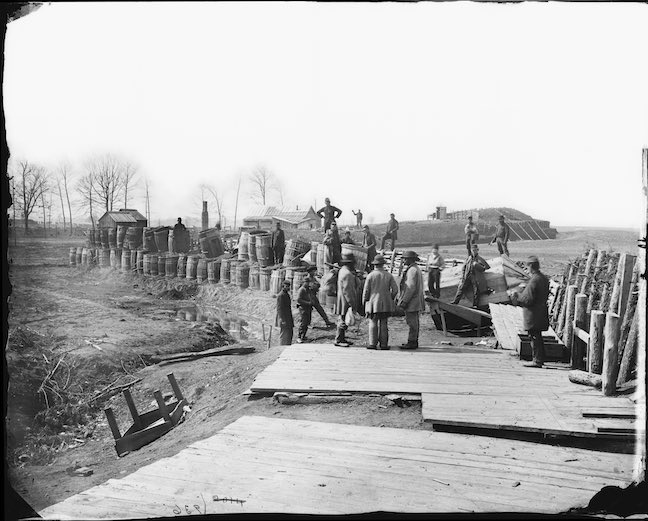| Credit: | by Barnard & Gibson |
|---|---|
| Date: | 1862.03 |
| Negative Size: | 8 in. x 10 in. |
| Equipment: | barrel |
| Locations & Lines: | Bull Run battlefield; Fort Beauregard VA; Manassas Junction VA; Virginia |
| Military Units: | CS Army; US Army |
| Sources: | Library of Congress; National Archives; USAMHI – MOLLUS collection |
$6.99
File Details: AIJXm, 750 DPI, TIFF, Original Negative, 41.5 Mb
Image ID: AIJX
Gardners Photographic Sketch Book Of The War. Vol. 1, No. 11. Fortifications at Manassas. March, 1862. This sketch represents a portion of the Confederate fortifications at Manassas after their occupation by the Federal Army. The works were laid out by General Beauregatd, well known as an engineer of great ability; but their construction illustrates the inexperience in military matters of the men who rallied at this spot to resist the authority of the Government. The casks were filled with earth, and were intended so supply the lack of more suitable gabions, but would have offered very little resistance to artillery. The flooring was laid for the use of the guns, the four short posts marking the embrasure. The interior of the works was badly drained, and the trenches were almost constantly filled with stagnant water. The fortifications formed a semi-circle about four miles in length, but contiguous to this position were the ridges and earthworks of Centreville, extending the line to nearly fifteen miles. The armament consisted principally of six and twelve-pounder field batteries, with a few old fashioned thirty-twos, brought from the Norfolk Navy Yard. Located, however, upon table-land, bounded by ravines and the almost impenetrable thickets bordering Bull Run, the works did not require very heavy ordnance. Had they been assaulted, the musket and bayonet would have proved far more serviceable in repelling the attack than artillery, although there is no doubt that the small number of heavy cannon was attributable to their scarcity in the South rather than to confidence in the natural strength of the position. The fortifications are now rapidly being leveled, and in a few years will have entirely disappeared. The soil composing them is of a light character, and washes away in every rain, filling up the ditches and reducing the sharply defined works to sloping mounds, over which the farmers slow is already turning the furrow.
Etched onto negative: 2014 [crossed out]. 936.
